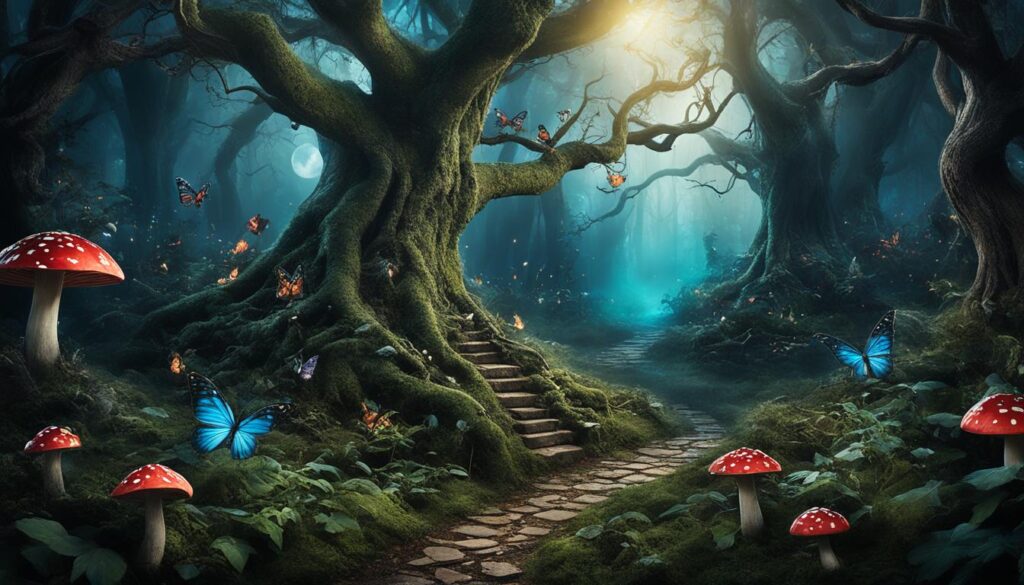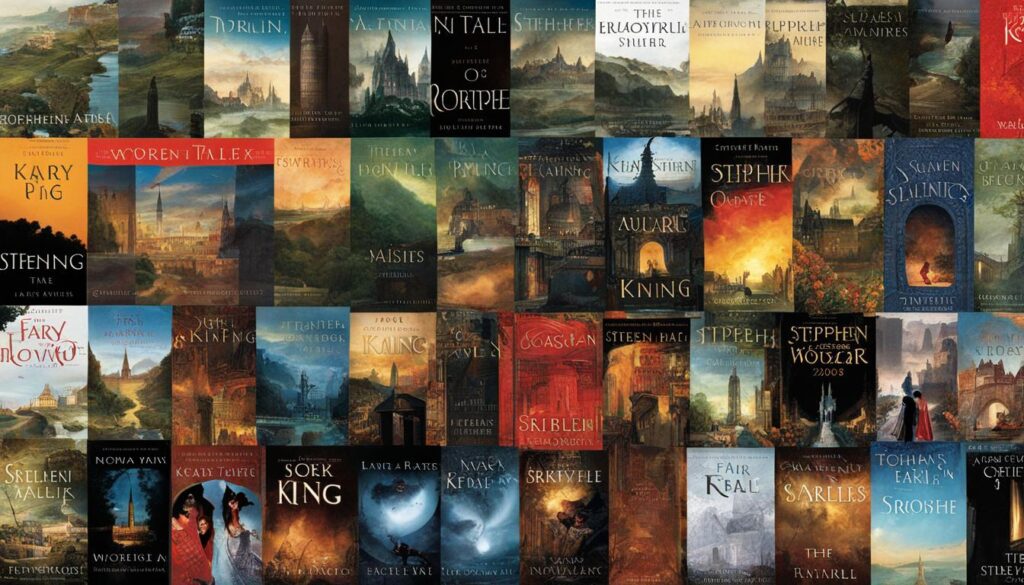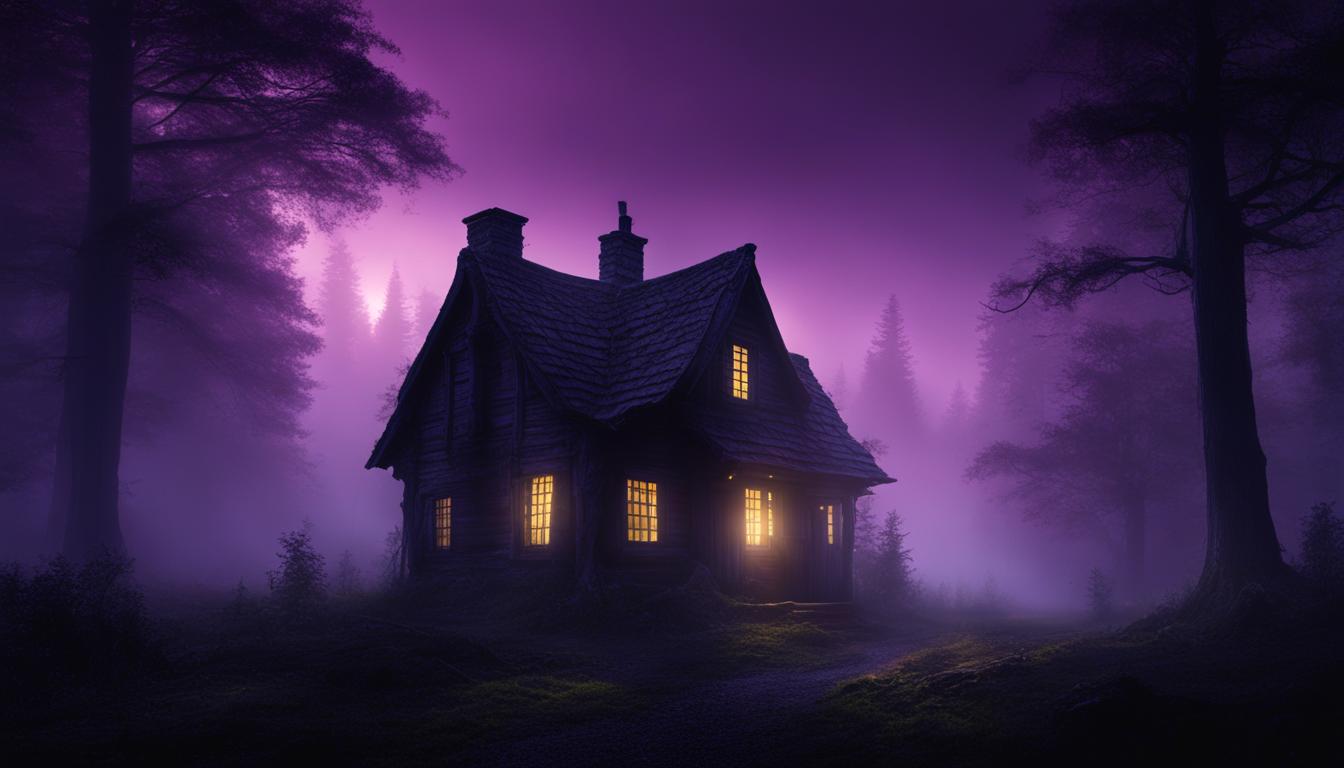Stephen King is an iconic writer known for his captivating and often terrifying storytelling. His ability to combine fantasy and horror has enthralled audiences for decades, and his fairy tales are no exception. In this article, we delve into the enchanting world of “cuento de hadas – Stephen King” and explore the intricate narrative techniques, dark themes, memorable characters, and atmospheric settings that make his fairy tales so compelling. Join us on this journey as we unveil the power of symbolism, recurring motifs, and analyze the global reception of Stephen King’s fairy tales. With his unmatched talent for blending traditional folklore and modern elements, Stephen King’s “cuento de hadas – Stephen King” is a must-read for anyone who loves fantasy and horror.
Exploring the Intricate Storytelling of Stephen King
Stephen King’s fairy tales are a testament to his unique storytelling abilities. His narrative style and techniques are unparalleled in the genre, making him a master of the art of storytelling. King’s ability to captivate readers with his storytelling is unmatched. His stories are replete with intricate plots, rich descriptions, and compelling characters that keep readers intrigued from beginning to end.
King’s storytelling is characterized by several unique elements. His use of foreshadowing and suspense creates an atmospheric tension that keeps readers on edge. He employs vivid imagery and sensory descriptions that help readers visualize the story’s settings and characters. Another hallmark of King’s storytelling is his ability to interweave complex subplots that enhance the story’s overall depth and complexity.
King’s storytelling techniques are not only entertaining but also thought-provoking. His stories often deal with complex emotions and themes that resonate with readers, including fear, love, loss, and redemption. Through his stories, King encourages readers to confront their fears and explore the darker aspects of the human psyche, making his tales both engaging and insightful.
Unveiling the Dark Side of Fairy Tales
Stephen King’s fairy tales are not for the faint-hearted. The intricate blend of fantasy and horror in his works showcases his mastery in seamlessly interweaving both genres. However, what sets his fairy tales apart is the dark and morbid elements that are often present in his storytelling.
From the evil witches and supernatural creatures to the graphic violence and gore, Stephen King’s fairy tales are not your typical bedtime stories. His unique take on traditional fairy tale motifs presents a new perspective, highlighting the darker side of these beloved tales.
King’s skill in crafting such intricate and unsettling narratives is a testament to his ability to push the boundaries of storytelling. Through his use of symbolism and vivid descriptions, he keeps readers gripped and engrossed in his twisted fairy tale worlds.
The Redemptive Power of Darkness
Despite the often disturbing content present in his works, Stephen King’s fairy tales offer more than just horror. The darkness present in his stories serves a larger purpose, shedding light on the human condition and the power of redemption.
King’s portrayal of good and evil is not as one-dimensional as traditional fairy tales. Instead, he shows that darkness and light are intertwined, and it’s through the struggles and hardships that we can emerge stronger.
Through his unique blend of fantasy and horror, King invites readers to confront their fears and delve into the deepest parts of the human psyche. His stories leave a lasting impact, challenging readers to grapple with their own darkness and grow from it.
Dark Elements in Stephen King’s Fairy Tales
| Dark Element | Fairy Tale | Significance |
|---|---|---|
| Graphic Violence | The Shining | Emphasizes the characters’ vulnerability and the horrors of the supernatural world. |
| Sexual Themes | Salem’s Lot | Offers a realistic portrayal of the destructive influence of lust and desire. |
| Psychological Horror | Cujo | Highlights the dangers of isolation and the fragility of the human mind. |
| Supernatural Creatures | It | Showcases the power of fear and imagination in shaping reality. |
In conclusion, Stephen King’s fairy tales are not for everyone, but those who dare to delve into his dark and twisted worlds will be rewarded with thought-provoking narratives that challenge their perspectives. His ability to blend fantasy and horror is unmatched, and his works will continue to haunt and captivate readers for generations to come.
Stephen King’s Signature Characters
Stephen King is known for his masterful character development in his fairy tales. His characters are often complex and memorable individuals that leave a lasting impression on readers.
From the innocent and vulnerable protagonist to the vicious and cunning antagonist, each character plays a significant role in driving the fairy tale narrative forward.
King’s ability to create three-dimensional characters allows the reader to form genuine emotional connections, making their struggles and triumphs all the more impactful.
The characters’ personalities are developed through their experiences, relationships, and internal struggles, making them seem like real people. Each character has unique motives and personalities that drive the plot and make the fairy tale come alive.
One example of King’s mastery of characters is the unforgettable “Carrie.” The story features a mistreated teenage girl with supernatural powers who is pushed to the brink by her tormentors. Her character arcs from a hopeless victim to a vengeful monster, leaving a lasting impression on readers.
Other notable characters include Roland Deschain from “The Dark Tower” series and Jack Torrance from “The Shining.”
King’s fairy tales are successful due to his portrayal of realistic and relatable characters that draw readers into the story. The characters play a crucial role in creating an immersive and unforgettable fairy tale experience.
The Role of Setting in Stephen King’s Fairy Tales
The atmospheric locations of Stephen King’s fairy tales play a significant role in shaping the reader’s understanding of the narrative. The settings create a dark, eerie atmosphere, reflecting the horror elements that are often present in his stories. From the ominous Overlook Hotel in The Shining to the rural town of Derry in It, King’s exceptional use of setting helps to build an immersive world that keeps the reader engaged throughout.
In his classic tale, “The Mist,” the setting of a small town, almost completely submerged in a fog, combines with supernatural elements, creating a sense of dread and claustrophobia for its characters and readers alike. Similarly, in “Salem’s Lot,” the setting of a small town infested with vampires adds to the tension that builds throughout the story leading to its chilling climax.
King’s use of setting isn’t limited to horror elements. In his novella “The Body,” the town of Castle Rock serves as a nostalgic backdrop for the four friends on their adventure to find a dead body. The town, with its small-town charm and picturesque landscape, provides a stark contrast to the dark themes of death and loss that the story touches upon.
Examples of Memorable Settings in Stephen King’s Fairy Tales
| Story | Setting |
|---|---|
| The Shining | The Overlook Hotel |
| It | The town of Derry |
| “The Mist” | A small town engulfed in mist |
| “Salem’s Lot” | A small town infested with vampires |
| “The Body” | The town of Castle Rock |
King’s mastery of setting is a testament to his ability to create fully realized and believable worlds for his readers to lose themselves in. The use of setting in his fairy tales adds depth and meaning to his narratives, highlighting his exceptional skills in storytelling.
The Power of Symbolism in Stephen King’s Fairy Tales
Symbolism is a powerful storytelling technique that Stephen King skillfully employs in his fairy tales. By imbuing objects, characters, and events with deeper meaning, King adds layers of complexity to the narrative, inviting readers to delve deeper into the story and uncover hidden truths.
One example of this can be seen in his classic tale, “The Shining.” The haunted Overlook Hotel serves as a symbol for the protagonist’s internal demons, as he is forced to confront his own past traumas and fears. The hotel itself is described as a labyrinth, representing the tangled maze of the protagonist’s mind. The eerie presence of ghosts represents the haunting memories that plague the protagonist. By using these symbols, King creates a deeply psychological and unsettling tale that lingers in the reader’s mind long after the story ends.
Another example can be found in “Carrie,” where the titular character’s telekinetic powers serve as a metaphor for her pent-up rage and frustration. Through this symbol, King explores themes of power and control, as well as the destructive consequences of unchecked emotions.
Overall, King’s use of symbolism adds a rich layer of depth and complexity to his already captivating fairy tales. Through careful and deliberate use of symbols, he is able to create stories that resonate with readers on a profound level, offering new insights and perspectives with each subsequent reading.
Themes and Motifs in Stephen King’s Fairy Tales
Stephen King’s fairy tales are known for their intricate storytelling, memorable characters, and atmospheric settings that blend the fantastical with the macabre. But beyond these surface-level elements lies a deeper layer of meaning and message that emerges through the recurring themes and motifs present throughout his works.
One such theme is the concept of power and its corrupting influence. Whether it’s through the power of magic or supernatural abilities, King explores how the pursuit of power can lead individuals down a dark path, ultimately resulting in their downfall. This can be seen in works such as The Stand and The Dark Tower series.
Another prominent theme in King’s fairy tales is the idea of innocence lost. His works often feature characters who are forced to confront the harsh realities of the world and are forced to grow up quickly in the face of danger and adversity. This is seen in books like It and The Body.
Along with these themes, King also employs a range of motifs that add depth and nuance to his storytelling. For instance, his use of the “outsider” motif can be seen in a number of his works, with characters like Carrie and Danny Torrance being outcasts who have to navigate a world that doesn’t understand them.

Through his consistent use of themes and motifs, Stephen King creates a rich and complex tapestry that draws readers in and keeps them engaged. Whether you’re a fan of horror, fantasy, or just great storytelling in general, his fairy tales have something to offer everyone.
Influences and Inspirations in Stephen King’s Fairy Tales
Stephen King’s “cuento de hadas – stephen king” are marked with a unique blend of traditional folklore and modern elements, showcasing the author’s creativity and visionary storytelling. Many literary and cultural influences have shaped King’s approach to fairy tales, inspiring him to craft immersive and captivating narratives that explore the boundaries between reality and fantasy.
Literary Influences
King’s love for Gothic and horror literature has been a defining factor in his fairy tale storytelling. He was inspired by writers like Edgar Allan Poe, H.P. Lovecraft, and Bram Stoker, whose works helped him to hone his skills in crafting suspenseful and eerie stories that leave readers on the edge of their seats.
Moreover, King was influenced by the works of J.R.R. Tolkien and C.S. Lewis, whose epic fantasy novels helped him to develop his world-building skills, creating intricate and believable realms that are laced with magic and wonder.
Cultural Influences
King’s fascination with the American culture and its folktales has been evident in his fairy tales. He has drawn inspiration from Native American, African American, and European American folklore, weaving these elements into his stories to create a rich and diverse tapestry of mythical creatures and legends.
Furthermore, King’s personal experiences and observations about human nature and society have been a significant influence on the themes and motifs in his fairy tales. He has explored topics such as addiction, mental illness, and the human condition, infusing his stories with a sense of realism that resonates with readers.
Stephen King’s use of literary and cultural influences in his fairy tales is a testament to his versatility and innovative storytelling. His passion for traditional folklore and modern elements has created a unique genre of horror and fantasy that continues to inspire and influence writers and readers around the world.
Impact and Legacy of Stephen King’s Fairy Tales
Throughout the years, Stephen King’s fairy tales have captured the hearts and imaginations of millions of readers worldwide, leaving an indelible mark on both contemporary literature and popular culture. His unique blend of fantasy and horror has created a new genre of storytelling, influencing a generation of writers and artists.
The enduring legacy of King’s fairy tales is evident in their continued relevance and popularity, with numerous adaptations for the big and small screen, as well as an ever-growing fan base. His work has had a significant impact on the way we understand the relationship between horror and fantasy, and on the way we think about storytelling itself.
The cultural significance of King’s fairy tales extends beyond the literary world, with references to his work appearing in music, movies, and television shows. His stories have become a part of our collective consciousness and continue to enthrall and terrify readers of all ages.
| Impact | Legacy | Fairy Tales |
|---|---|---|
| ● Created a new genre of storytelling | ● Continues to be relevant and popular | ● Blend of fantasy and horror |
| ● Influenced a generation of writers and artists | ● Numerous adaptations for screen | ● Ever-growing fan base |
| ● Changed the way we understand horror and fantasy | ● Enduring cultural significance | ● Part of our collective consciousness |
Stephen King’s fairy tales are more than just scary stories. They are gripping narratives that explore the human experience in all its complexity and darkness. They have influenced generations of storytellers and will continue to do so for years to come.
Exploring International Reception of Stephen King’s Fairy Tales
Stephen King’s fairy tales have captivated audiences across the world, charming readers with his masterful blend of horror and fantasy. The international reception of his works has been phenomenal, with translations in over forty languages and availability in countless countries.
The appeal of King’s fairy tales transcends cultural and linguistic differences, with readers from every corner of the globe flocking to his books. His ability to create vivid, relatable characters and compelling narratives has garnered widespread acclaim and adoration.
King’s fairy tales have become a global phenomenon, with many countries adapting his works for film and television. The international impact of such adaptations has only added to the fervor surrounding his stories, cementing his legacy as one of the most captivating storytellers of our time.

The Popularity of Stephen King’s Fairy Tales by Country
| Country | Translated Titles Available | Domestic Film Adaptations |
|---|---|---|
| Germany | 72 | 14 |
| France | 58 | 9 |
| Spain | 48 | 7 |
| Italy | 40 | 5 |
| Japan | 36 | 3 |
These numbers are a testament to the universal appeal of King’s fairy tales, showcasing the widespread enthusiasm for his works around the world. From Germany to Japan, King’s stories continue to enchant and intrigue audiences, reinforcing his status as a beloved and time-honored author.
Conclusion
In conclusion, Stephen King’s “cuento de hadas – stephen king” is a captivating and spellbinding world where fantasy and horror intertwine to create a unique and unforgettable reading experience. King’s intricate storytelling techniques, memorable characters, and atmospheric settings are woven together to produce a narrative that keeps readers on the edge of their seats.
Through his use of symbolism, recurring themes and motifs, and dark elements, King has established himself as a master of blending fantasy and horror in his fairy tales. His enduring influence and legacy are evidenced by the global popularity and universal appeal of his works, which have been translated into numerous languages and continue to inspire contemporary storytelling.
Stephen King’s fairy tales are a testament to his unparalleled skill as a writer and his ability to transport readers to a world of magic and terror. Whether you’re a die-hard fan of the genre or simply curious about exploring the dark and enchanting world of “cuento de hadas – stephen king,” his works are not to be missed.



